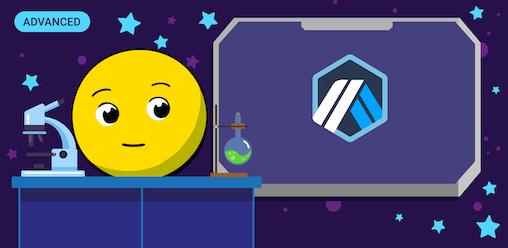
Arbitrum is a second-level solution for the Ethereum network, which is used in smart contracts for better functioning. When using Arbitrum in smart contracts, the transaction processing speed increases, opportunities for scaling appear, and commissions within the network decrease. At the same time, additional functions, such as privacy, appear.
To do this, developers do not need to rewrite their applications from scratch because Arbitrum supports the Ethereum Network Virtual Machine (EVM) and allows you to run unmodified Ethereum virtual machine contracts and ETH transactions on the second level while retaining all the advantages of the original Ethereum blockchain of the first level.
Their Mission
The developers of Arbitrium want to create an application that works as a complete financial platform that allows users to actively participate in the cryptocurrency economy using various decentralized applications (dApps).
Its goal is to combine many financial instruments at the same time. Arbitrum can create a world in which everything related to finance and economics is assembled on a single platform. This means accessing bank accounts, investing, exchanging cryptocurrencies and fiat, borrowing, lending, saving, selling, and buying stocks, stocks, and derivatives.
Arbitrum is the absolute leader in the Layer 2 sector, ranking first in terms of blocking volume of $2.064 billion, this share of TVL is 55.6% of the entire L2 sector. On August 31, 2021, Offchain Labs, the company behind Arbitrum, announced the official launch of the long-awaited main network of Arbitrum One.
Currently, well-known DeFi protocols are deployed in the Arbitrum network, including Uniswap, Sushi, 1inch, and Curve. SushiSwap is the largest DeFi TVL project on the net. GMX is a decentralized platform for trading perpetual contracts, where users can trade various digital assets with leverage up to x30. As for inter-network bridges, Multichain, Hop and other cross-chain bridges have also added support for Arbitrum networks. And TreasureDAO is the main marketplace of NFT after Arbitrum.
Roll-up Technology
Arbitrium uses Roll-up technology, which implies that the task of processing Ethereum transactions is assigned to the layer 2 chain, while the Ethereum mainchain is mainly responsible for security issues. After each chain completes the calculation, the transaction information is summed into the call data, and then periodically packed into blocks and sent to each shard chain (to level 1) to complete the recording.
Rollup technology as a whole can be divided into Op-Roll-up (optimistic) and zk-rollup (zero-knowledge). The previously mentioned Arbitrum and Optimism belong to Op-Rollup.
Optimistic Rollups
Instead of checking each transaction at layer 2, the main network simply broadcasts them and "optimistically" assumes that they are legitimate, if this is not disputed by anyone. Calculations occur only when fraud is proven in case of problems.
Optimistic Rollups can offer improvements in scalability because they don't perform any calculations by default. Since computing is a slow and expensive part of using Ethereum, Optimistic Rollups can offer up to 10-100-fold scalability improvements. This number will become even larger with the transition to Ethereum 2.0.
As an Op-Rollup project, the Arbitrum network has good compatibility with EVM. Projects based on Ethereum smart contracts can be easily transferred to the Arbitrum network.
Advantages of the Arbitrum DApp
Arbitrum is widely used by the Ethereum community. The main advantage of this application is that it allows everyone to trade without requiring permission from third parties such as financial institutions and banks. Arbitrum is free and decentralized from all government regulations, which can cause various problems with traditional fiat currencies. With this platform, users do not need an account, and the currency cannot be stored or controlled by governments or banks.
Thus, there are no risks associated with arbitrage trading. Another advantage of cryptography is its anonymity. Only sellers and buyers know each other, unlike banking when many people have access to your information. Different people can access your credit cards and account numbers.
Anonymity makes it almost impossible to steal a person's identity and prevents people from using arbitration anonymously because you have to provide identification before joining. Many of the available cryptocurrencies have a limited supply, which makes it difficult to devalue digital assets in the future. On the other hand, fiat currencies can be easily printed out of thin air at any given time.
Arbitrum does not charge a transaction fee when trading with other users, and no third-party permission is required to perform transactions on the platform.
Anyone can become a validator and check if someone is trying to cheat. Validators monitor cases with the opening of disputes. Users who are not validators can become victims of fraud only if all 100% of validators are in collusion. Level 2 is safe as long as at least one honest validator remains online. Moreover, the network will be safe even if all validators are pests, but are not in collusion to consistently and consistently lie.
When the act of fraud is proven, the rogue validator is slashed and loses his deposit. His part goes to the "detectives" who brought him to the surface. This motivates network participants to behave honestly and makes sabotage unprofitable.
How to Use
Similar to the interaction with the Optimism network, to interact with the Arbitrium network, you first need to transfer assets to the network through a network bridge. Arbitrum can be added to your wallet application via chainlist.org, and then transfer to the Arbitrum network using an official Arbitrium bridge or another cross-chain bridge. Also on the ARBITRUM ONE PORTAL, you can view the entire Arbitrum ecosystem, find the dap you are interested in and work with it.
Let's Summarize
The Ethereum network has been incredibly overloaded for a long time — users can't wait to migrate to the “Ethereum suburbs” and take a breath of fresh air. The ecosystem opens many of its branches based on Layer 2, which affects the record drop in gas prices on the mainnet.
DeFi projects are rushing at full speed to new fertile lands and trying to stake out their plots there. After a while, they launch their applications. There is an influx of users who want to save on commissions. Each DeFi project does everything possible to convince newcomers to use only its application and not pay attention to competitors. Along the way, projects issue tokens and offer tempting rewards to attract as much economic activity as possible.
At the same time, L2 solutions, such as Arbitrium, will distribute their own Arbitrium token using DeFi applications, thus supporting the decentralization of Layer 2.
In short, we are waiting for a new DeFi-summer. Only this time the scale of what is happening will be much more grandiose: firstly, there will be two sources of token issuance on L2 at once. Secondly, the land on the second level will become incredibly expensive in the long term.

